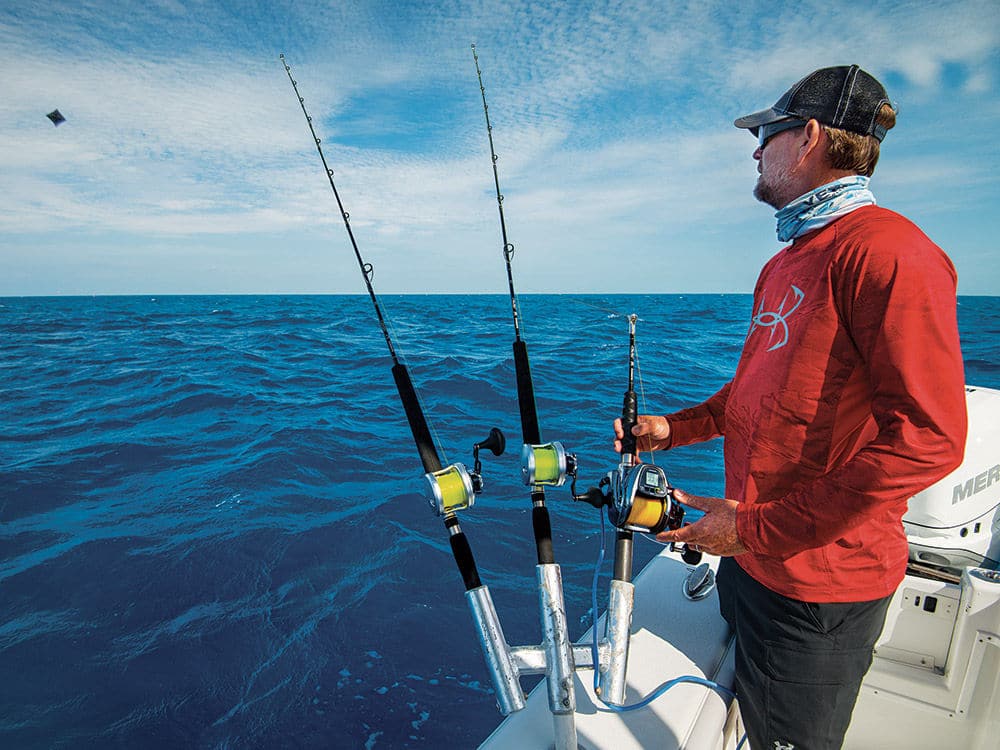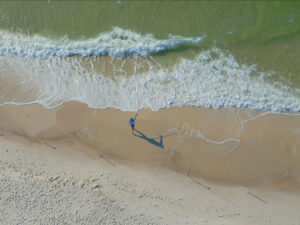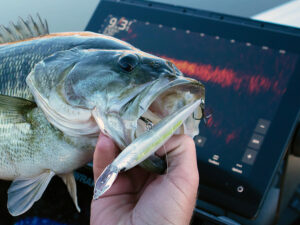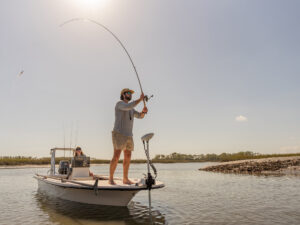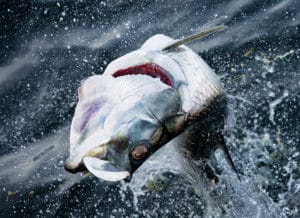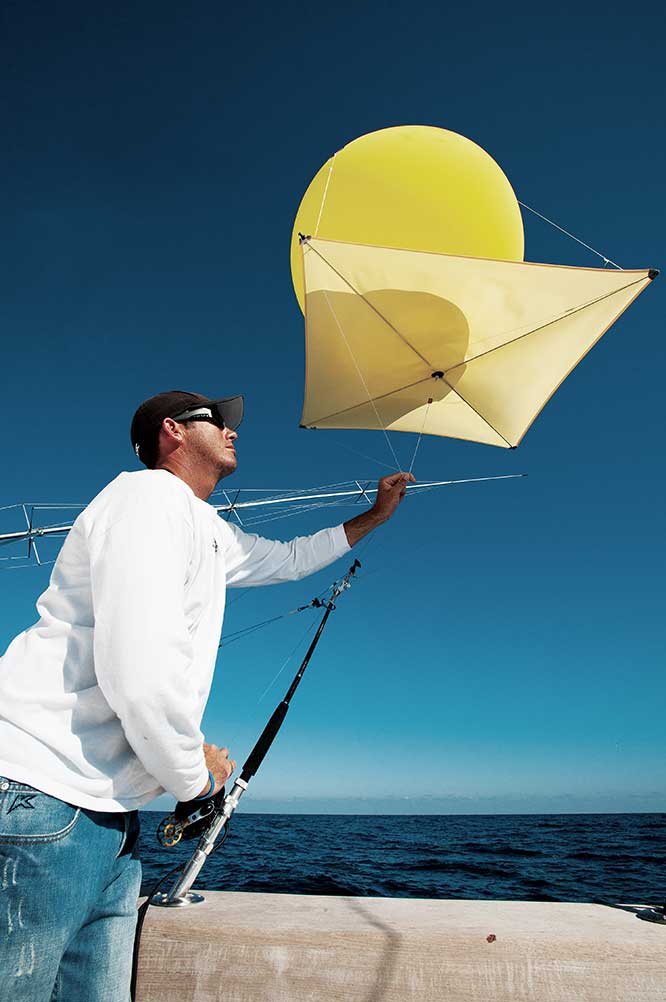
Serious kite-fishermen will tell you that kite-fishing is a remarkably productive way to live-bait fish offshore. Nearly any species that swims near the surface and feeds on baitfish is tempted by struggling herring, goggle-eye, menhaden, mackerel or mullet. From billfish to tunas, wahoo to king mackerel, the target list is plentiful.
If the fish are concentrated in a specific area, or following a specific path up- or down-current, most experienced anglers set out two kites with two or three baits each. South Florida winter sailfishing is probably the best-known kite-fishery, but across the country in California, long-range boats use kites with live flying fish to catch monster tunas while slow-trolling.
The proper kite can make or break a day of fishing. Simply put, all kites don’t fly in all conditions. You’ll need to fly different types of fishing kites in no wind, light winds or heavy winds. Plus, before engaging in kite-fishing, anglers must have the necessary know-how, a properly outfitted boat, and the right tackle.
Thankfully, understanding your kite options and when to use them might be the cheapest and easiest process of the bunch. Most fishing kites are square in shape and measure 28 to 38 inches in length, with averages in the 30s. Kite materials are lightweight out of necessity; both Tigress and Lewis Fishing Kites incorporate variants of polyester. AFTCO uses 6-ounce rip-stop nylon sailcloth because it’s durable, waterproof and simple to fly. SFE was tight-lipped about its material when asked. Depending on the kite maker, the difference between kites built for light or heavy winds are mere ounces and inches.
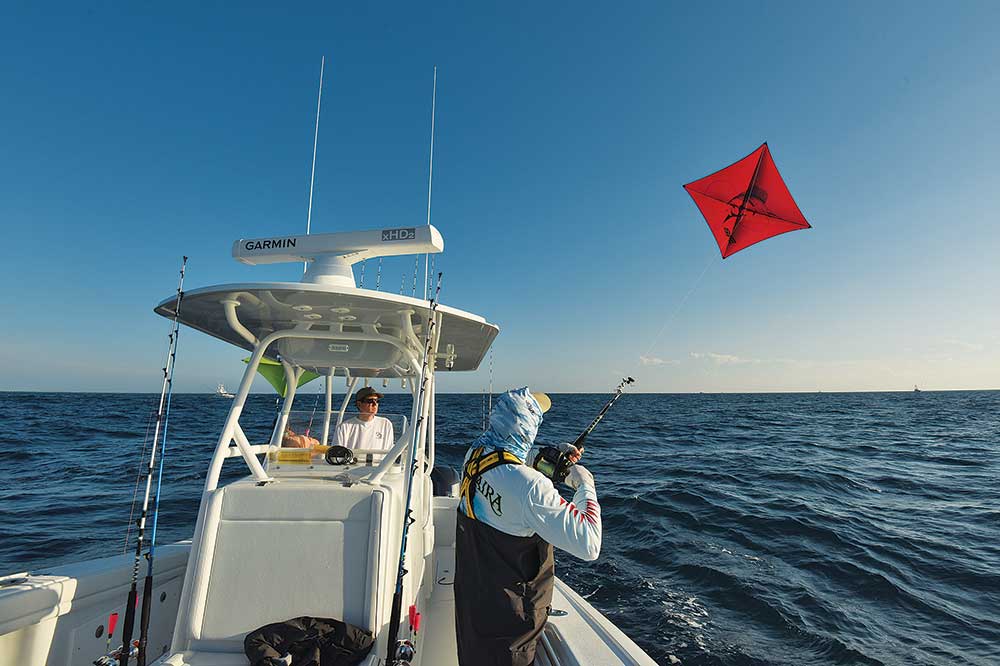
How to Fly Your Kite for Fishing
Anglers new to kite-fishing are often clueless how to fly kites.
The basics of kite flying dictate that the greater the wind, the more pressure is forced upon the kite. Lighter kites used in light winds catch as much air as possible. To relieve unwanted wind pressure, the kites built for heavy winds include holes to take pressure off the face of the kite, the spars and kite line.
“Less pressure also means it’s easier for anglers to retrieve the kite,” says Phil Slaga, owner of SFE Kites. “You can easily have 15 to 20 pounds of pressure on a kite, and that’s why electric reels are so beneficial.”
Kites want to follow the air currents, and most wind turbulence is closer to the water. Find clean air for the kite to take off. Go to the bow if you must; stand tall to get the kite above the T-top. Fishing kites requires a balance between size and holes. The larger the kite, the larger the separation between kites when flying two in a spread. Adding split-shot weights to a specific side can move them directionally too.
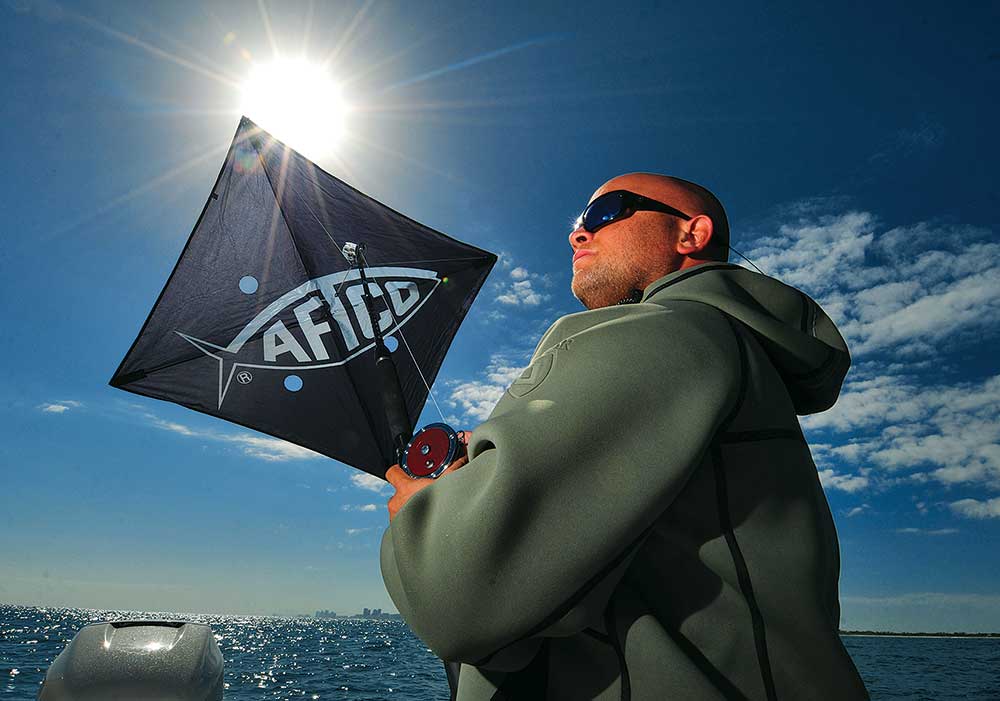
Rigging Your Kite for Fishing
Capt. Jimmy Lewis, owner of Lewis Fishing Kites, explained how kite-fishing started within his family. His father, Capt. Bill Lewis Jr., pioneered modern kite-fishing off South Florida.
“My grandfather, Bob Lewis Sr., was in World War II, stuck on a signal ship in Guam,” says Lewis. “He noticed baitfish were on the flats, but the yellowfin tuna were farther offshore. So he created a kite from a cotton shirt to get baitfish out to the tuna. He wanted to eat something other than K-rations. In 1946, my dad started building kites, and we’ve only gotten better at it since then.”
The optimal way to set the kite is to tune it right out of the box.
First, set the bridle so it flies at maximum height. That usually means moving the bridle slide up. Rig the kite to the kite line, and launch the kite to make sure it flies steadily.
“The AFTCO kite’s bridle can be let out to allow the kite to vent more wind off the bottom surface and provide more lift,” says Greg Stotesbury, AFTCO tackle sales manager. “For every inch the bridle is extended, the AFTCO kite will gain approximately 15 degrees of height off the horizon. The reverse is true when the bridle is shortened.”
If you need the kite to fly right or left to keep it away from the boat or another kite and over open water, crank the rig back to you and add split shots to the side of the kite that correspond with the direction you want it to fly. You want separation between a spread of two kites, which is helped by a kite’s tendency to steer right or left. Knowing that the kite flies lower with the weight of the split shots, adjust the bridle again to fly at a height that handles two or three baits.
A Comparison of Top Kite-Fishing Options
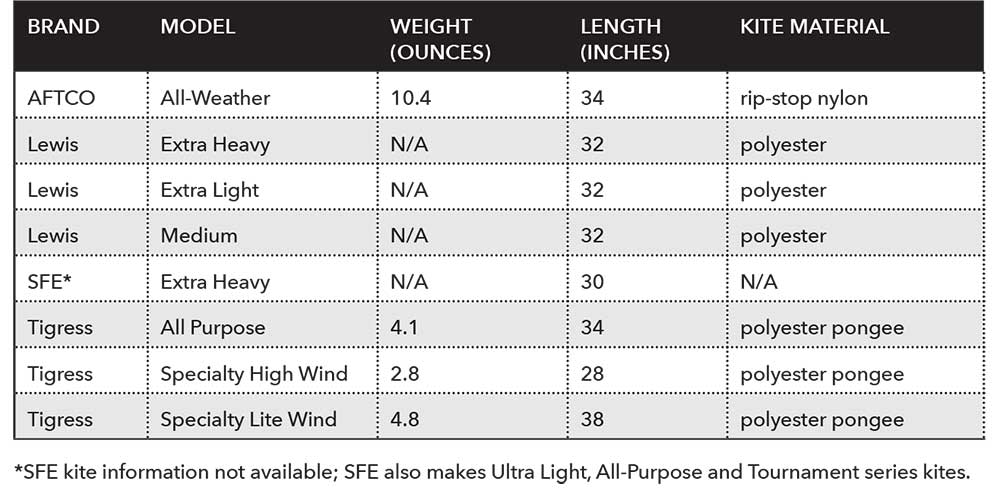
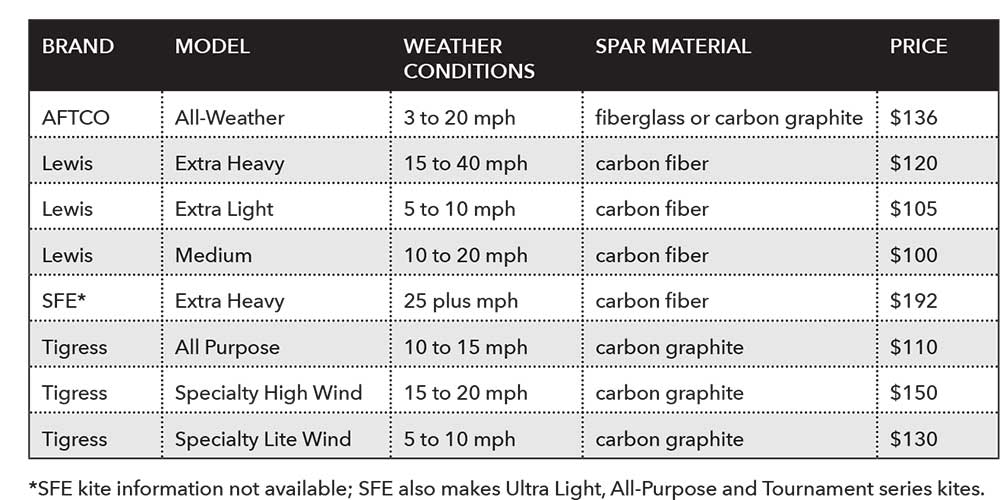
Lightweight Kites for Fishing
AFTCO produces a single kite ($136) that works in winds from 3 to 20 mph.
“It is a single sail with two different sets of replaceable spars,” says Stotesbury. “The lighter spars are good for 3 to 10 mph winds, and the medium spars are meant for 9 to 16 mph winds. For heavier winds, both sets of spars are used to add extra weight, stiffness and stability for high winds.”
Tigress Specialty Lite Wind ($130), SFE Ultra Light ($188) and Lewis Extra Light ($105) kites are all built to fly in the 5 to 10 mph range without a helium balloon. (Helium balloons affixed to light-wind kites have long provided extra lift on those truly listless days.)
These lightweight kites have no holes and can grab all available air, creating tighter kite-line tension than a ballooned kite. Tight kite-line tension allows an angler to better pull fishing lines from kite clips, especially when compared with droopy kite lines on lighter days.
The higher a kite flies, the more wind it catches. So on really light-wind days, put the boat in gear to get the kite up, says Slaga. “That might mean starting in much deeper or shallower water, depending on the wind direction and current. Once the kites get well past the T-top, often there’s enough wind to keep them flying without the need for a balloon. A lighter kite line also helps.”
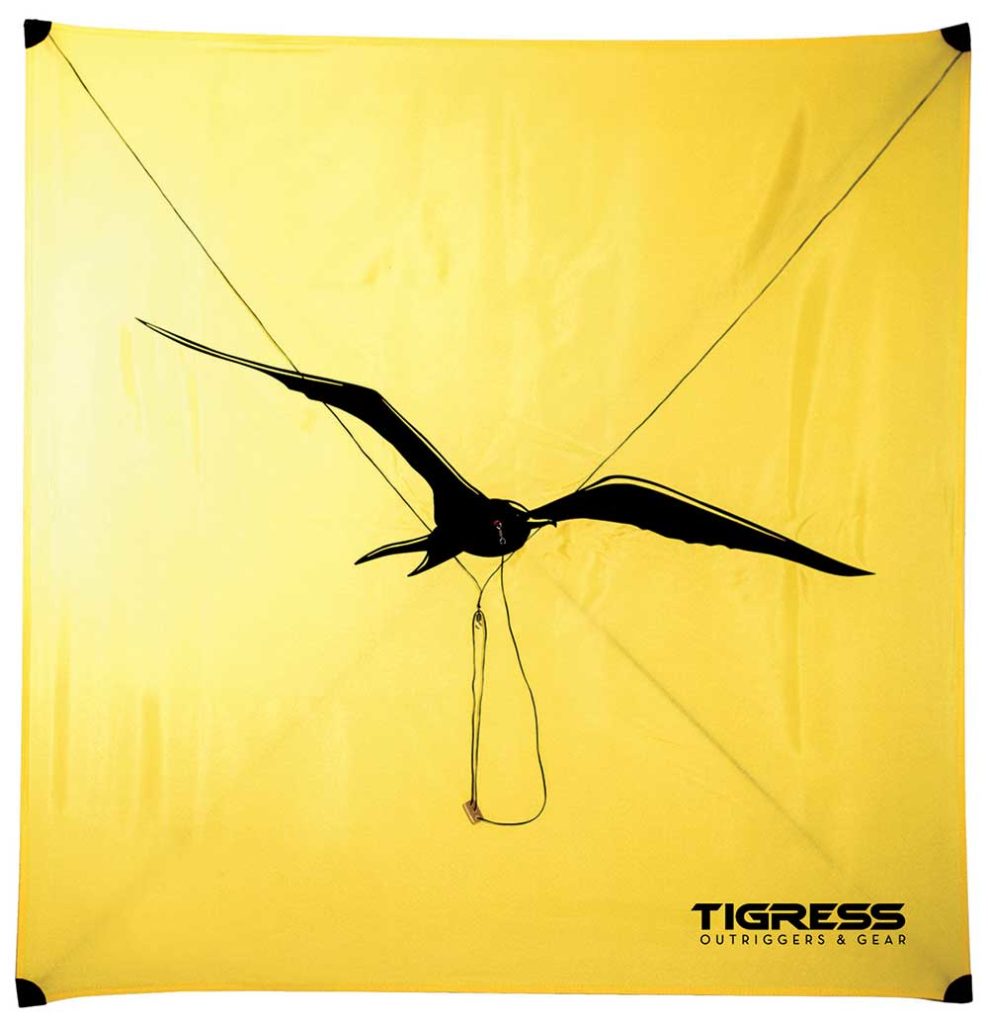
Most Versatile Fishing Kites
Companies such as AFTCO, Lewis, SFE, Tigress and others also make kites for the more-common 10 to 20 mph wind days. Some of the kites’ ranges are even wider, and it’s up to you to recognize their limits. The Lewis Medium ($100), SFE Ultimate ($117) and Tigress All Purpose ($110) kites are just some of the options available in this category.
“Mono testing 50 pounds works well as kite line for medium winds,” says Stotesbury, “but heavier 65- to 90-pound braided lines are best for heavy-wind conditions.”
This class of kites is the most commonly used because of its versatility in everyday wind speeds. For a kite to fly optimally, try to take some of the load off the kite. Heavier winds usually means you’re flying kites lower, while light winds means you’ll try to fly your kite higher. You don’t want spars or kite line to break during a gust of wind.
“The more angle you add to your kite, the higher it wants to fly,” says Slaga. “Use the bridle to change the attack angle of the kite. Try to keep an angle in the kite so an unexpected wind gust forces the kite higher, not into the water. Because of their flexible frames, kites will actually start to collapse under heavy wind, which prevents them from continuing their climb too high.”
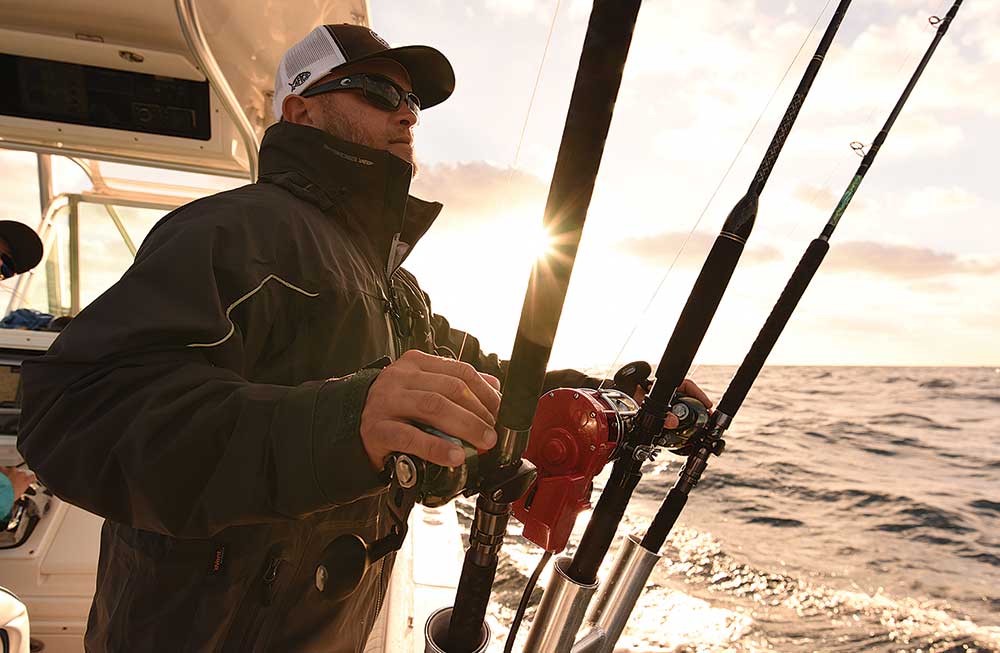
Best Fishing Kites for Heavy Winds
Winds above 25 knots require a whole new class of kites, one that sheds wind instead of harnessing it.
“The primary reason a kite can handle stiffer winds is that the stiffness of the spars allows the kite to maintain its shape and still have lift,” says Stotesbury. “The other component for heavier winds is the kite’s ability to allow wind to pass through the sail due to porous fabric or holes serving as vents.”
The AFTCO and Lewis Extra Heavy ($120) kites feature four symmetric holes. Tigress’ Specialty High Wind ($150) kite has 40 holes. SFE offers 52- and 40-hole kites, but the company just introduced a new, smaller extra-heavy kite ($190) that replaces the 52 option.
“In general, smaller kites tend to be harder to keep in the air,” says Slaga. “So when a boat turns down-sea to chase a fish, a smaller kite that can still handle high winds and not fall from the sky is preferable.”
The Lewis Extra Heavy kite was designed for hardcore tournament anglers who might fish in 35- up to 40-knot winds, says Lewis.
“What’s unique about our kites is that most of them float,” says Lewis, referring to the floats on his kites’ spars. “When they go down, they can still be retrieved by an adept captain. That solves a huge, expensive problem — anglers don’t want to lose their kite if conditions go south. And in my experience, fishermen want to kite-fish whenever they can; I’ve noticed I catch almost five times as much with a kite when compared with slow-trolling.”
Once you’re set up with the right kite, you’ll want to make sure your boat is kite-fishing friendly. After that, consider which reels you’re using, especially if targeting sailfish. Click the link below to find the best reels on the market to tackle sailfish.
